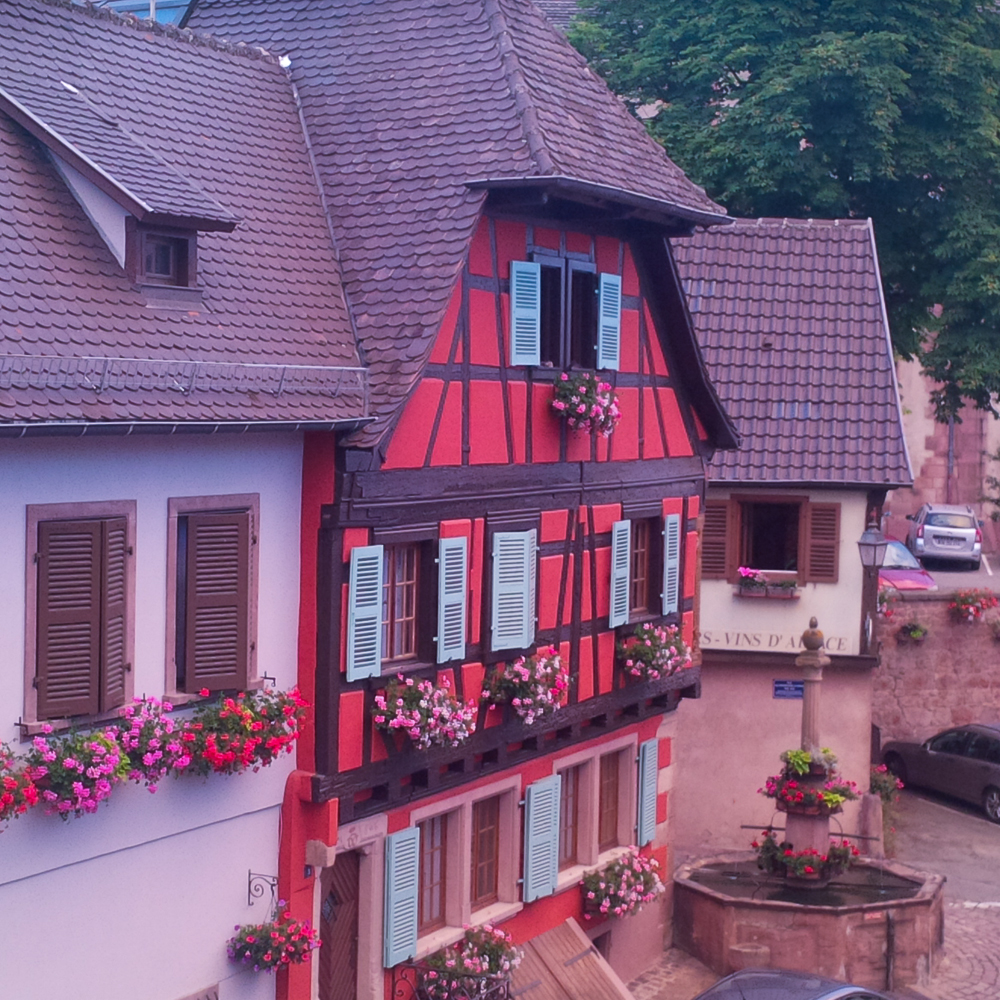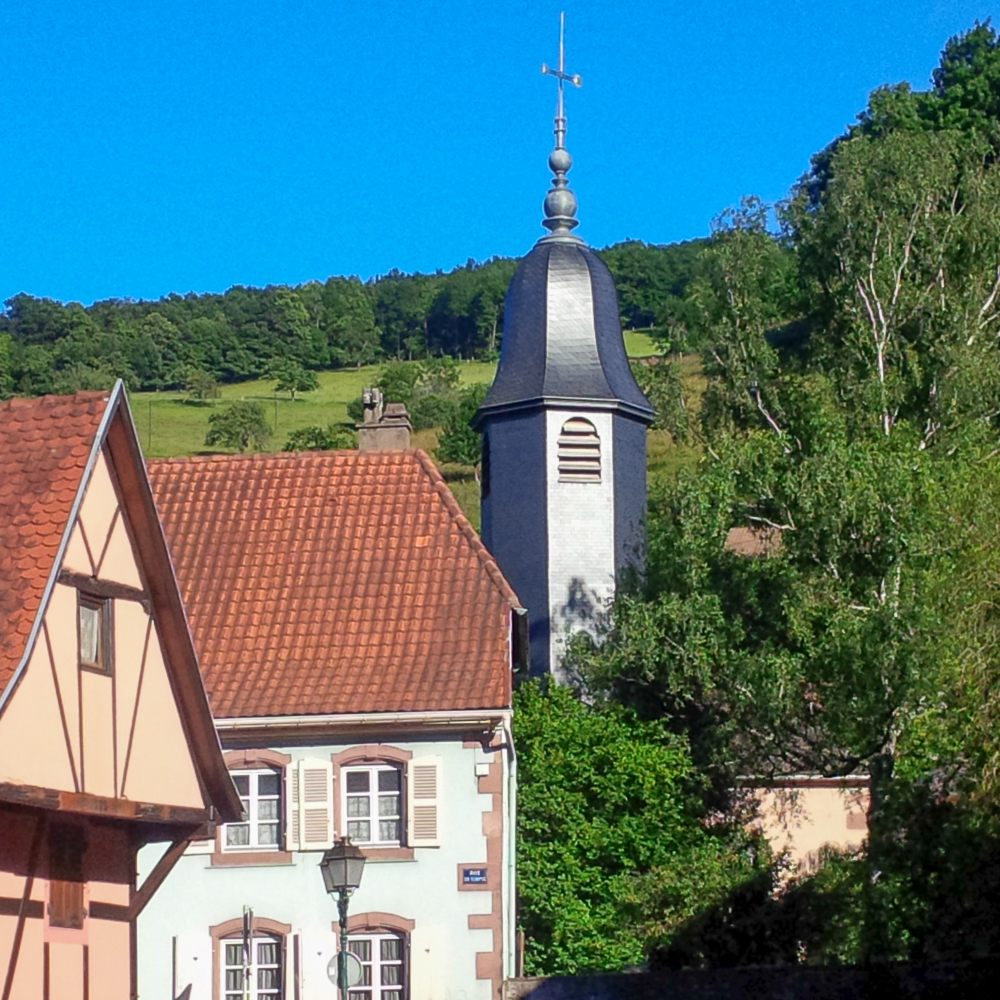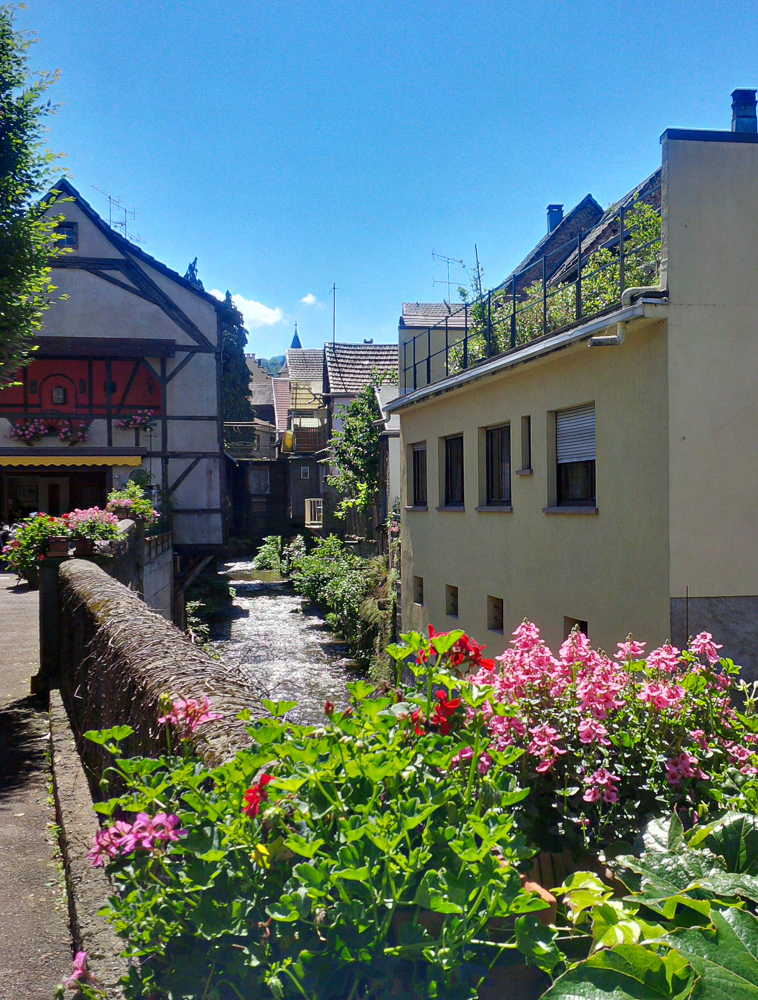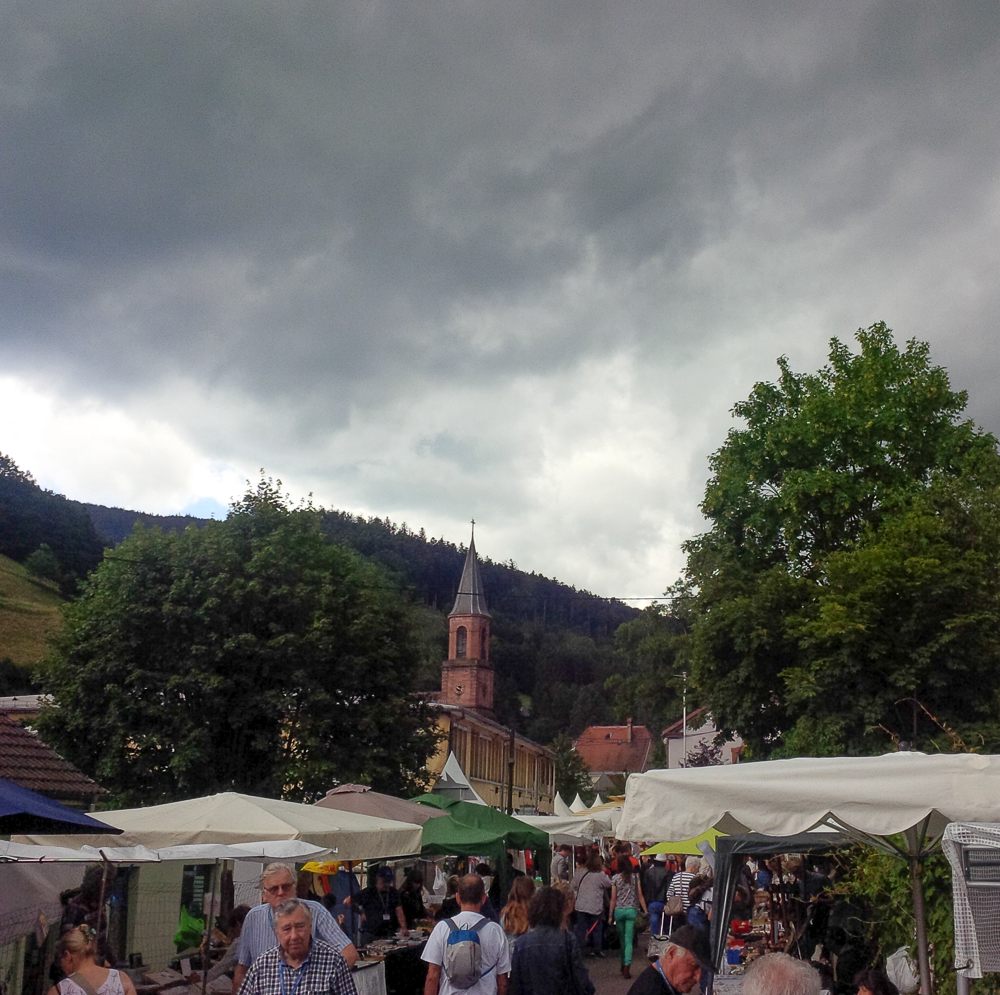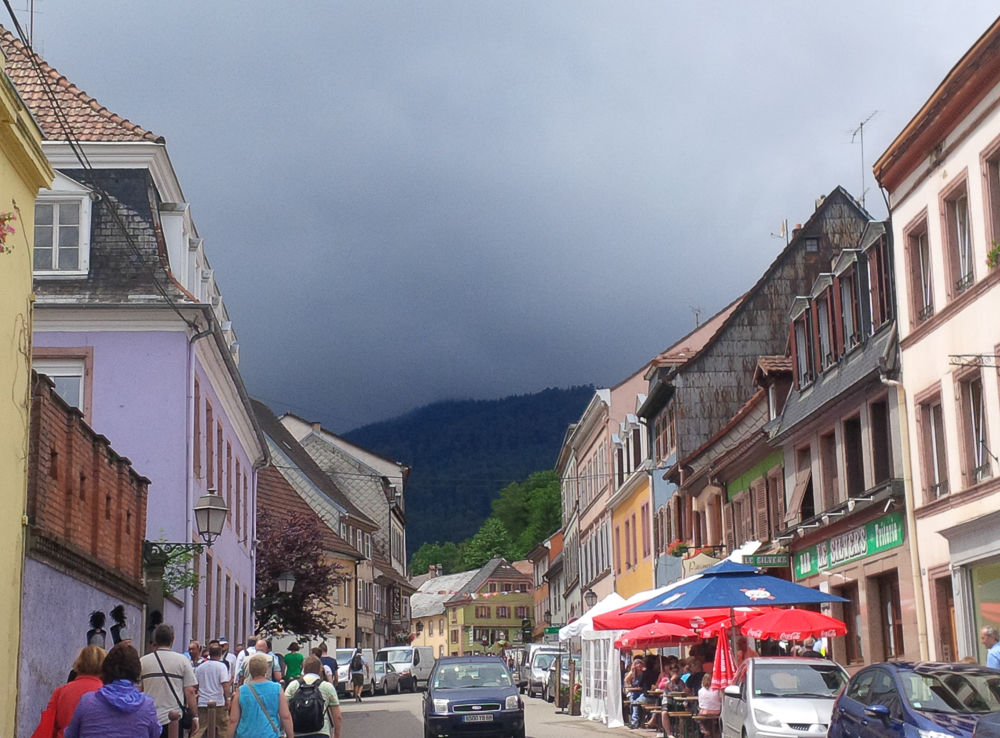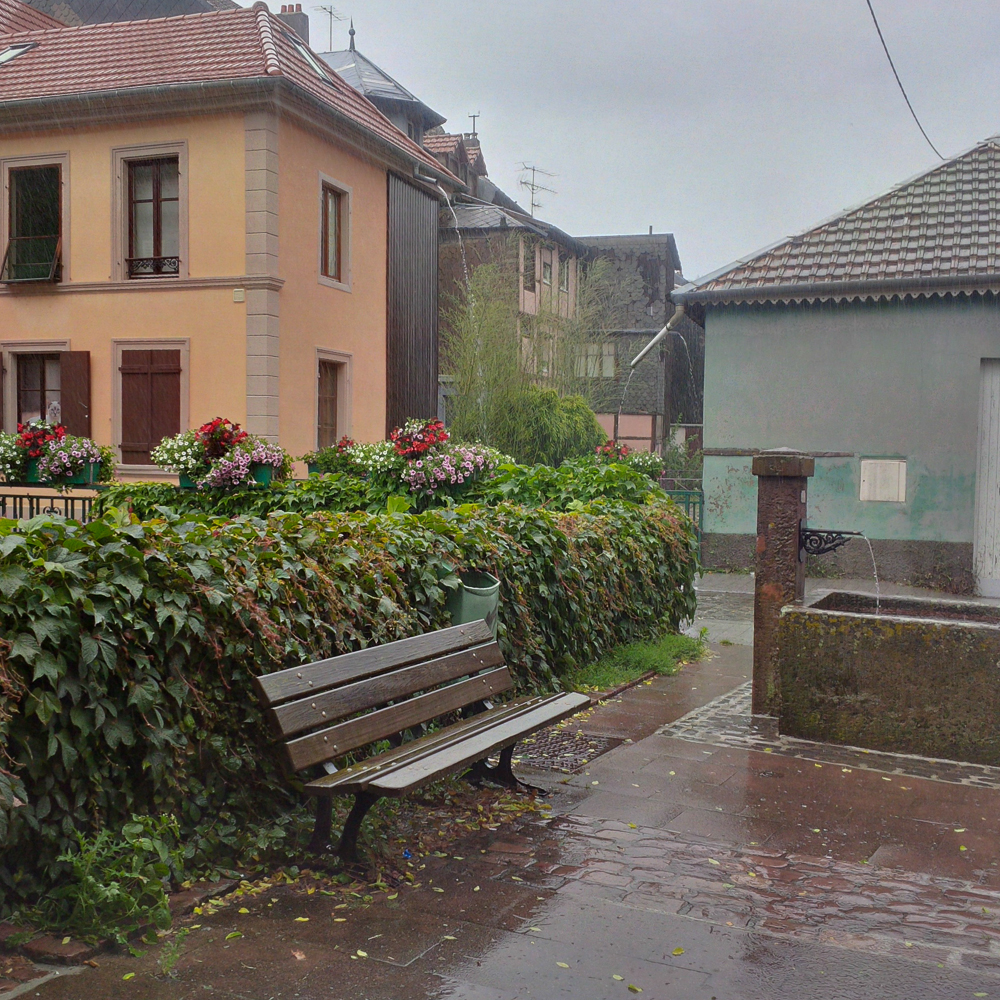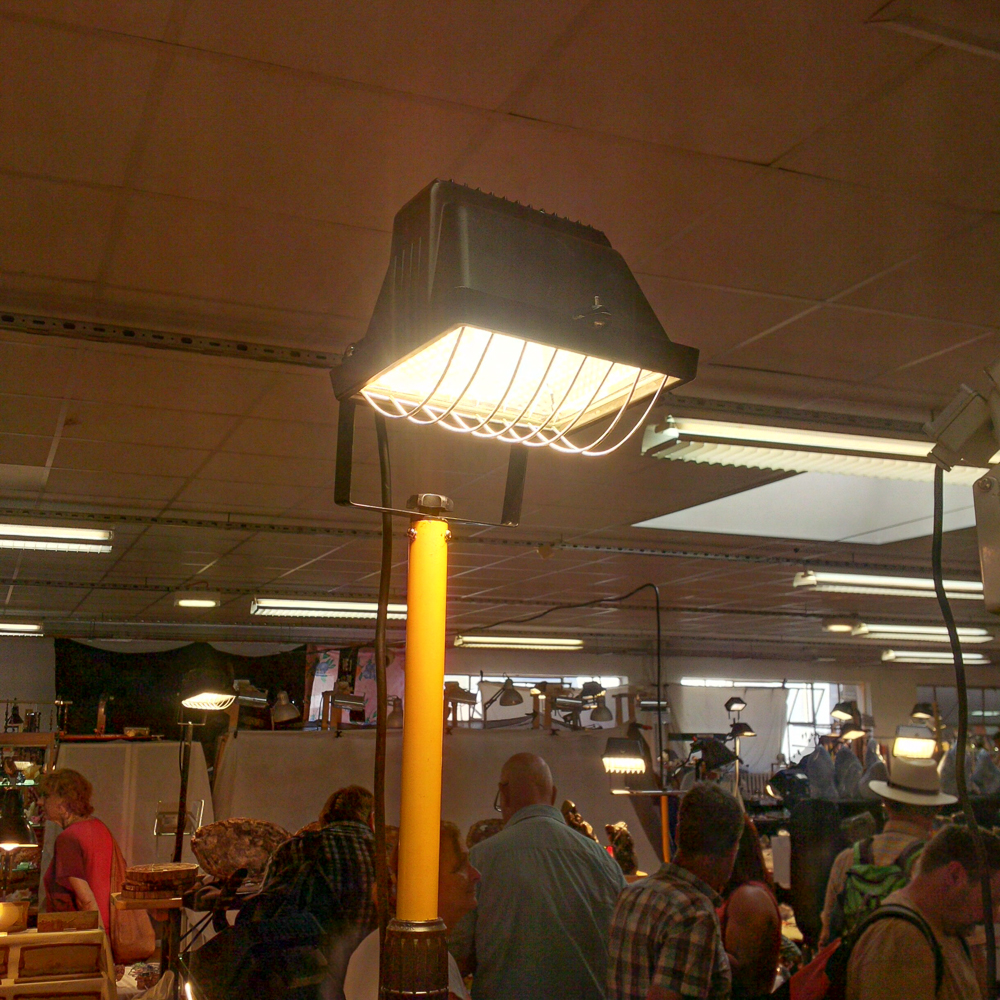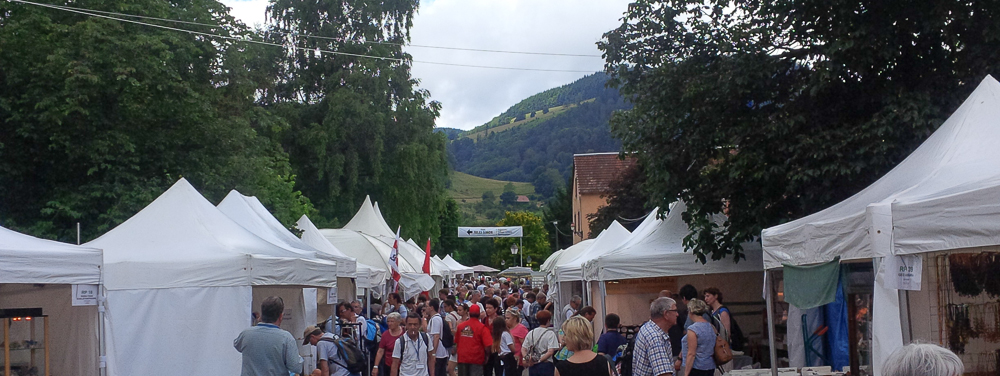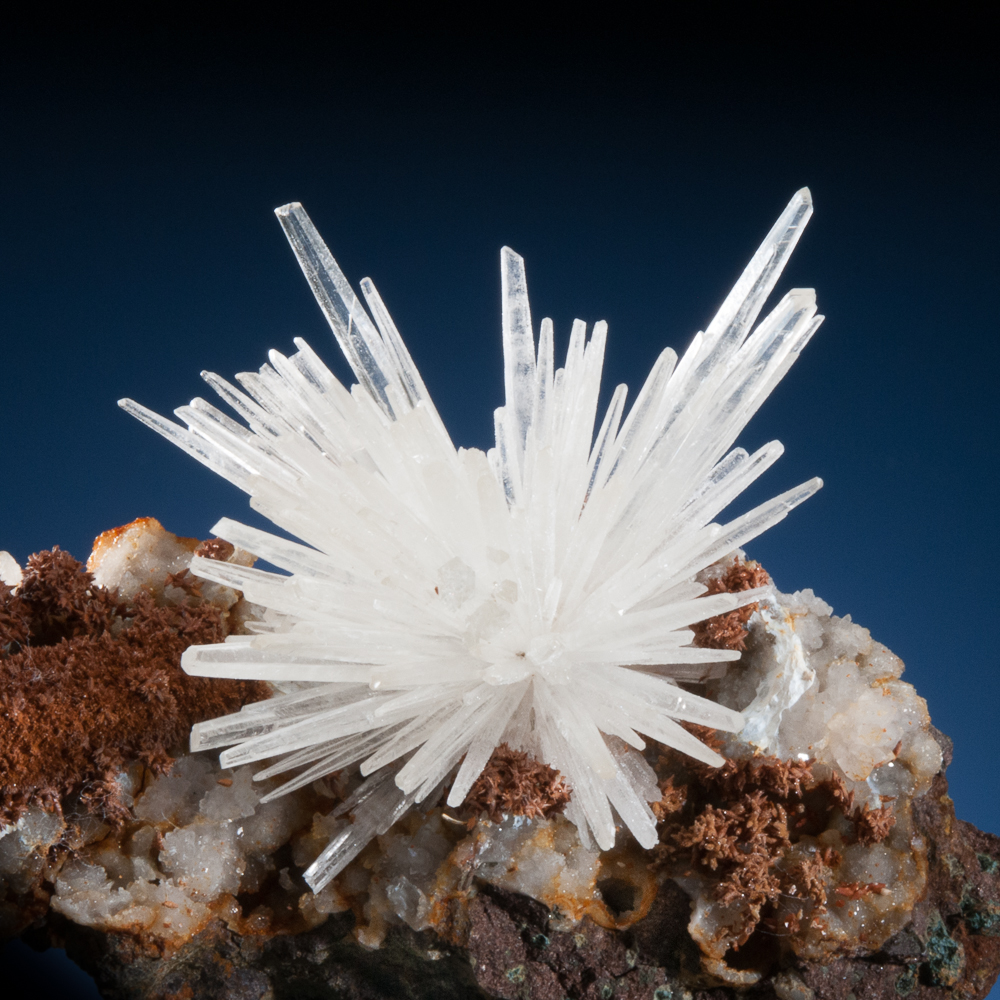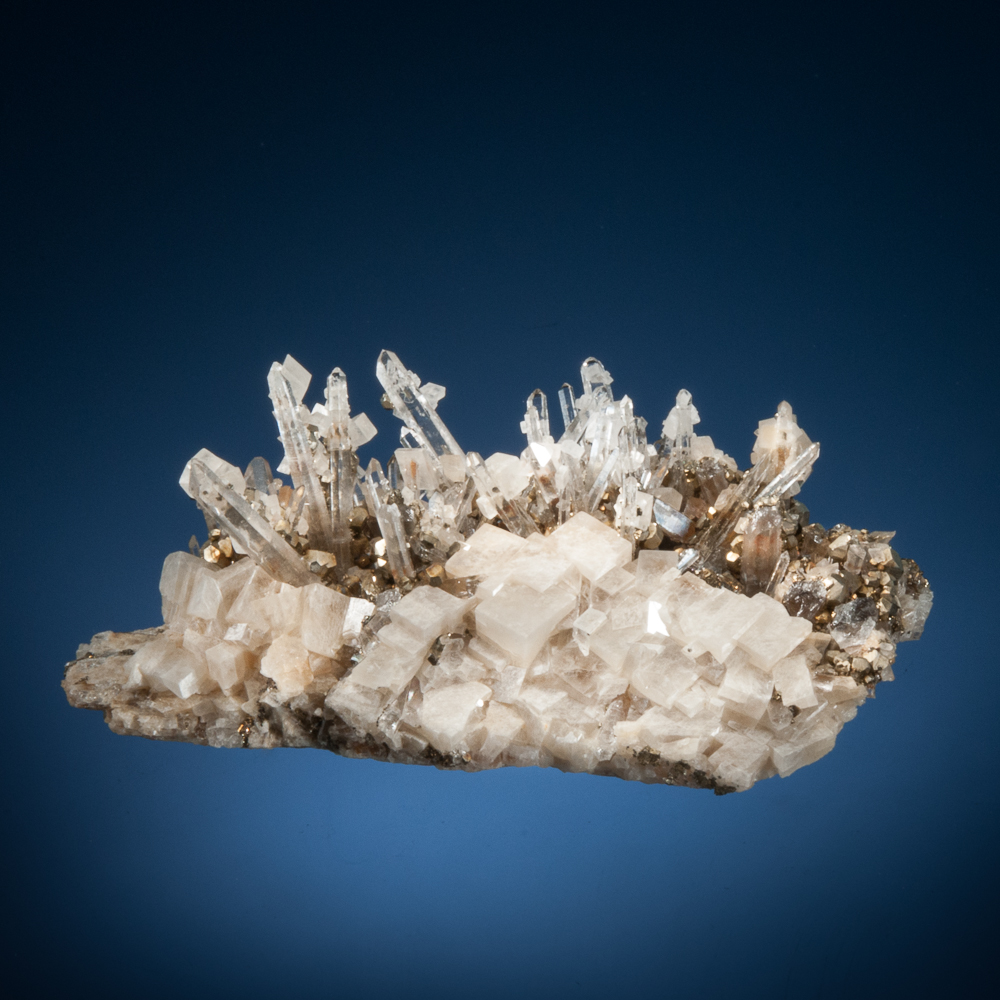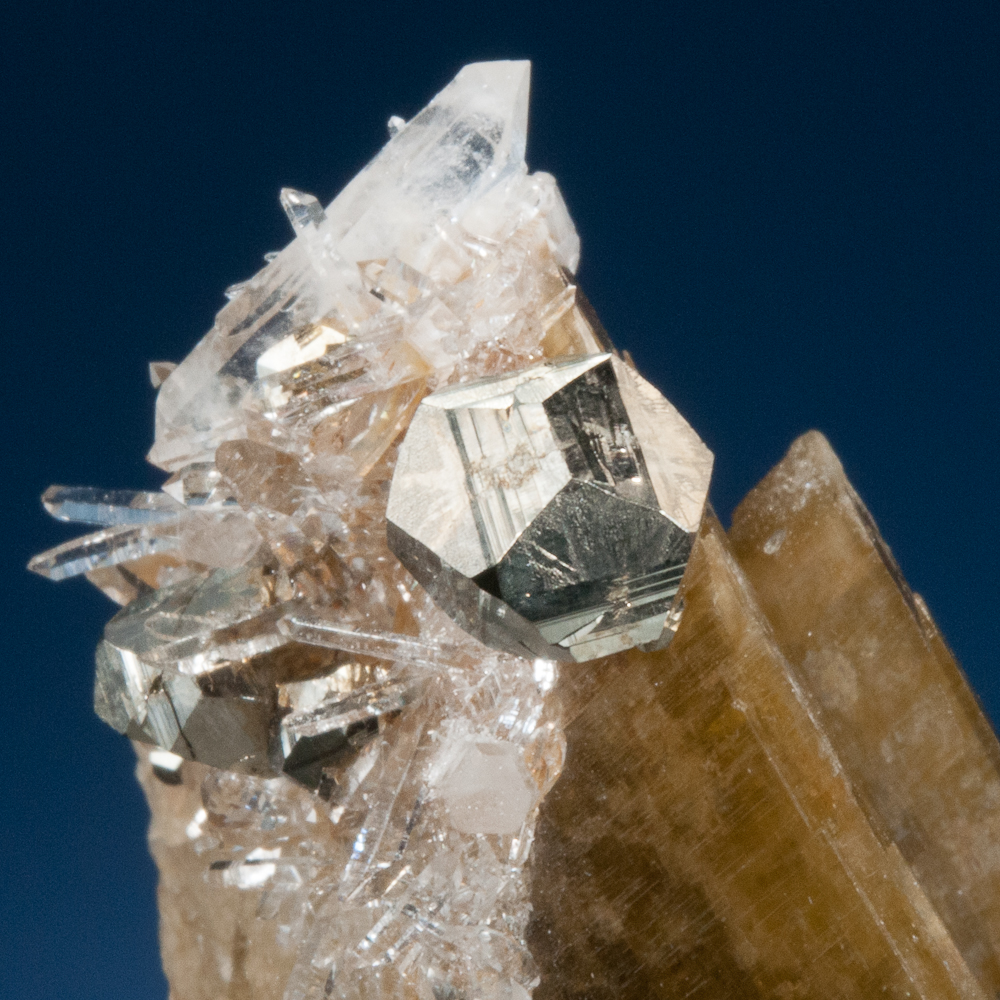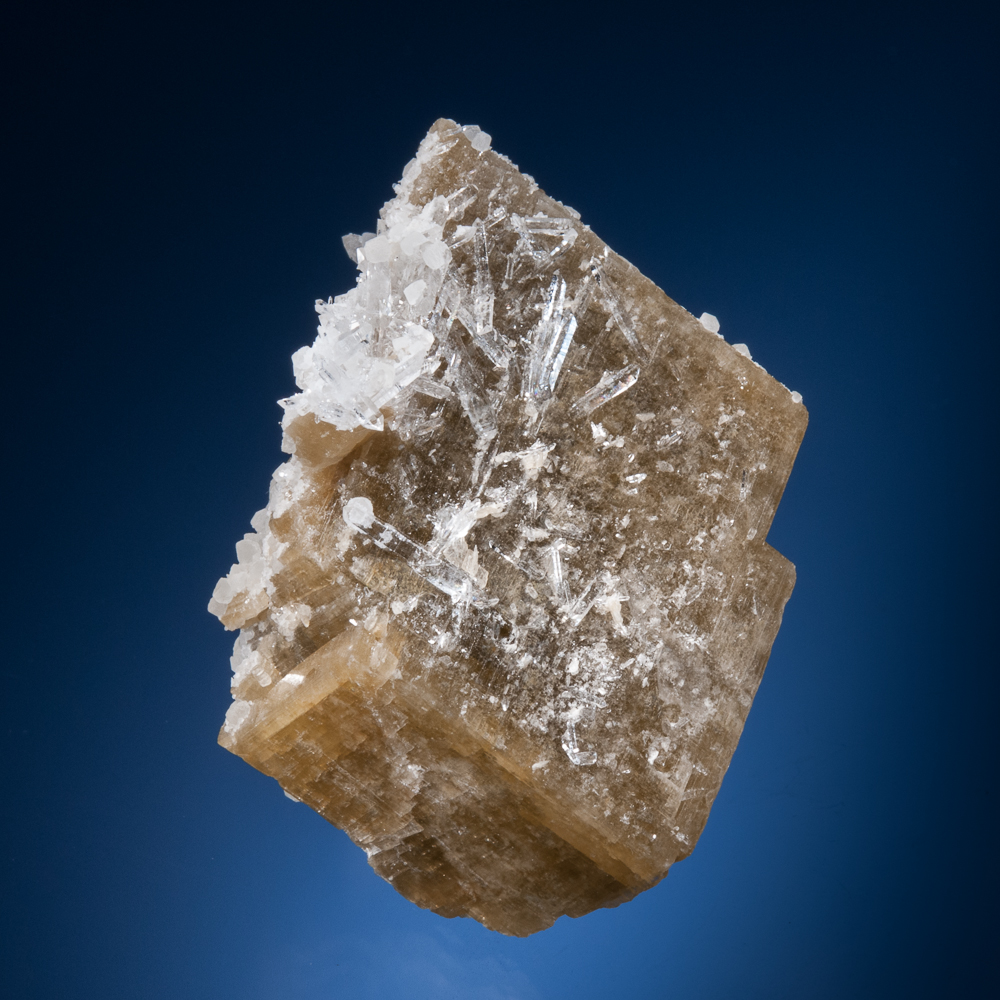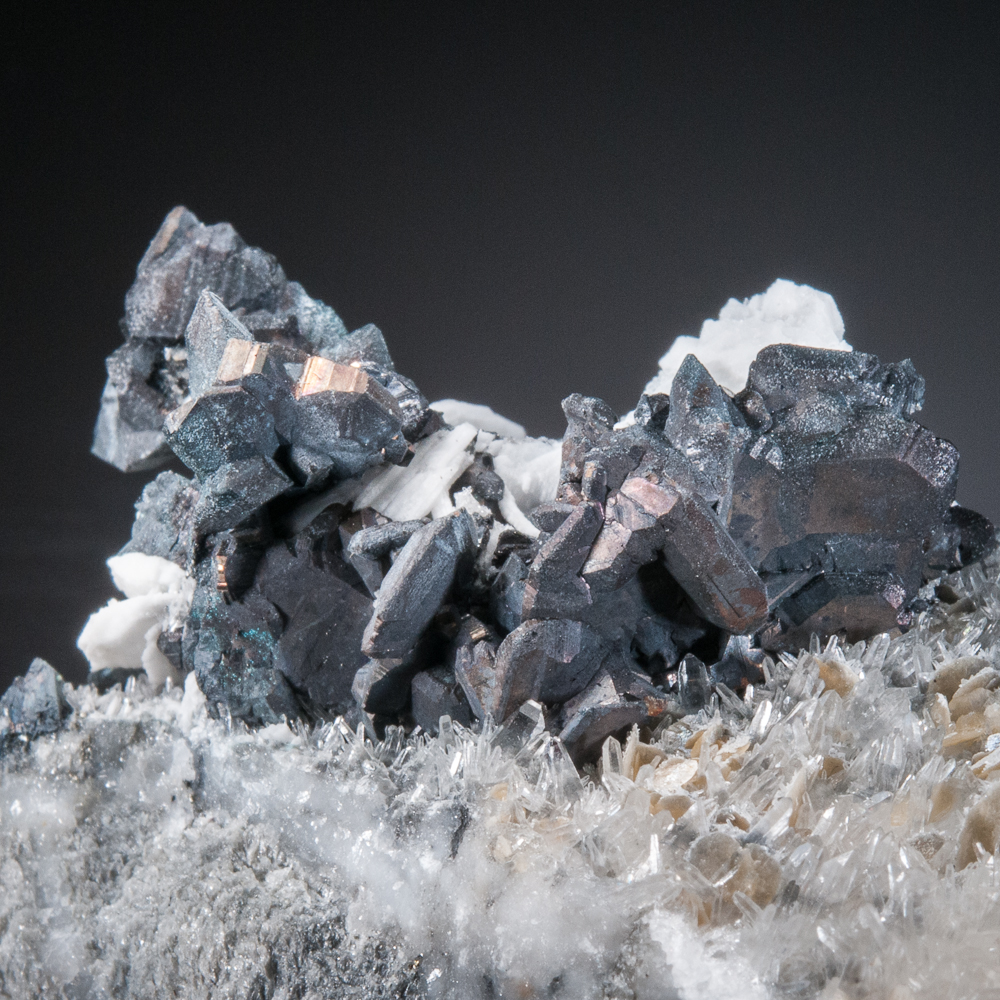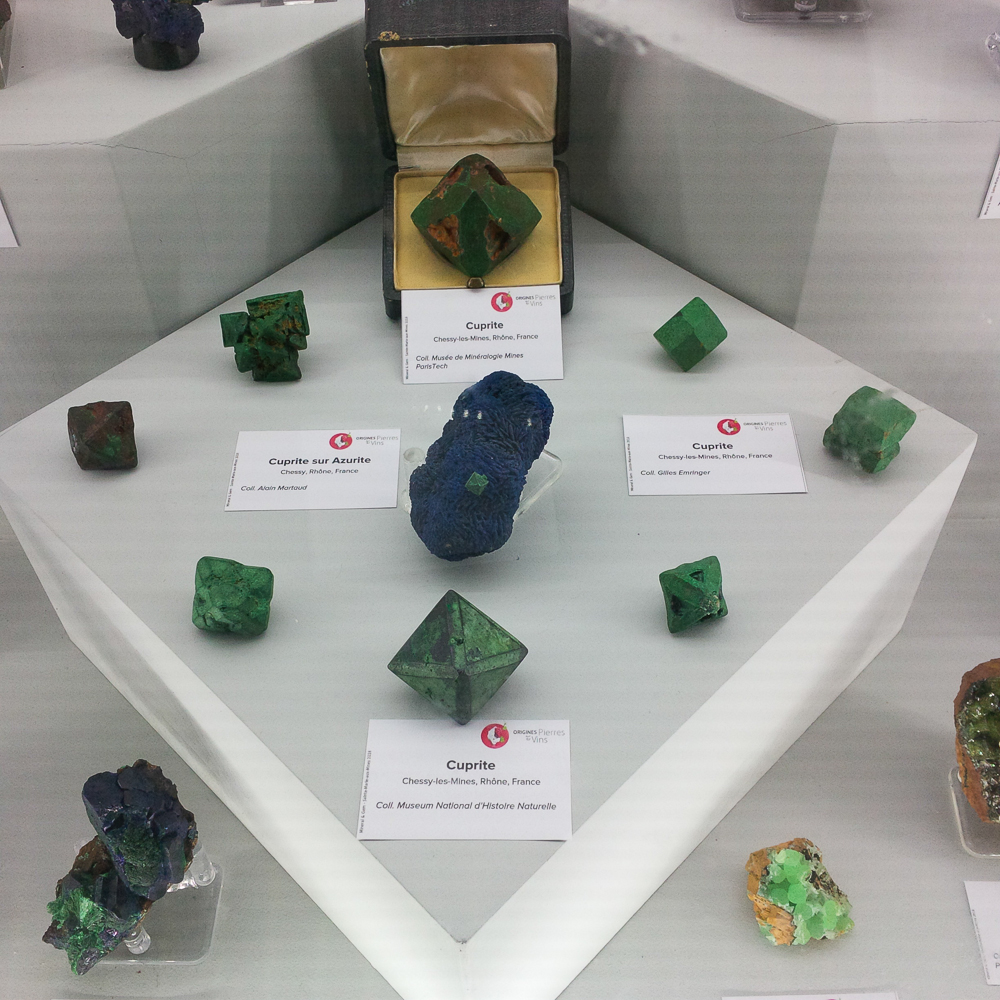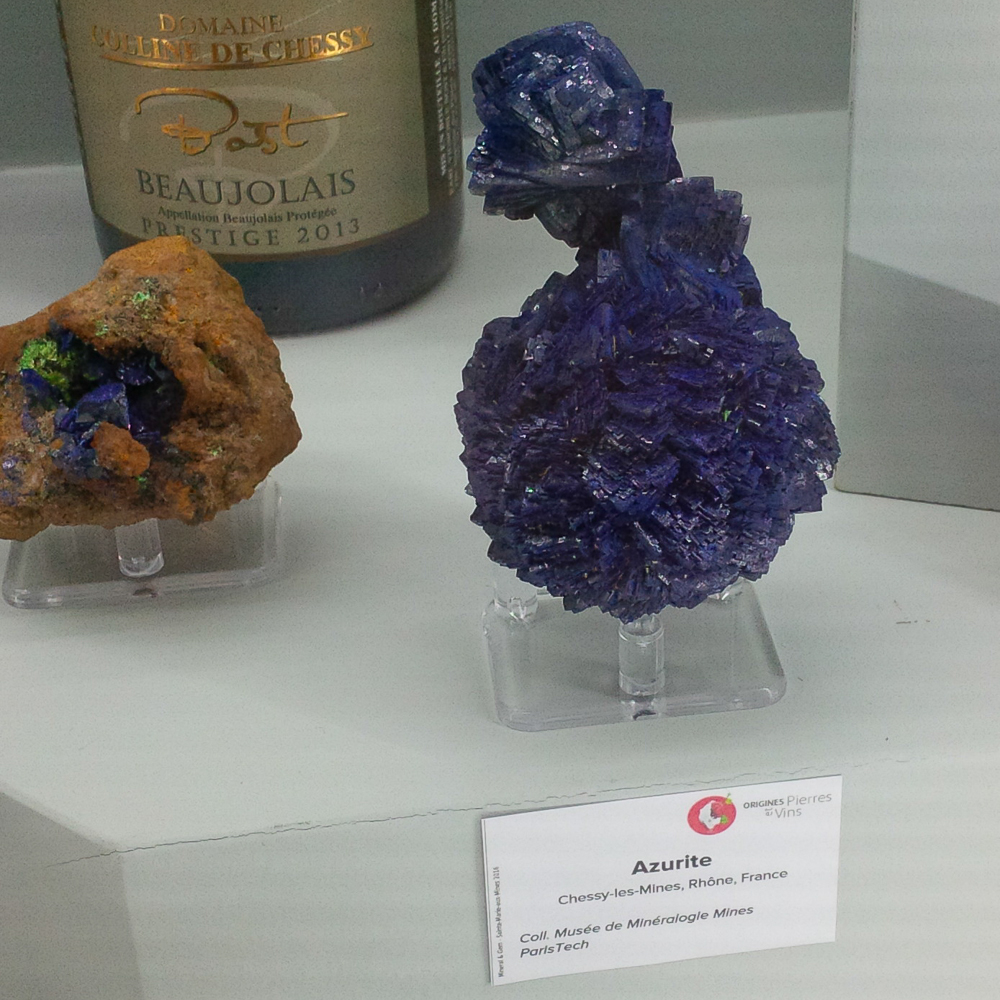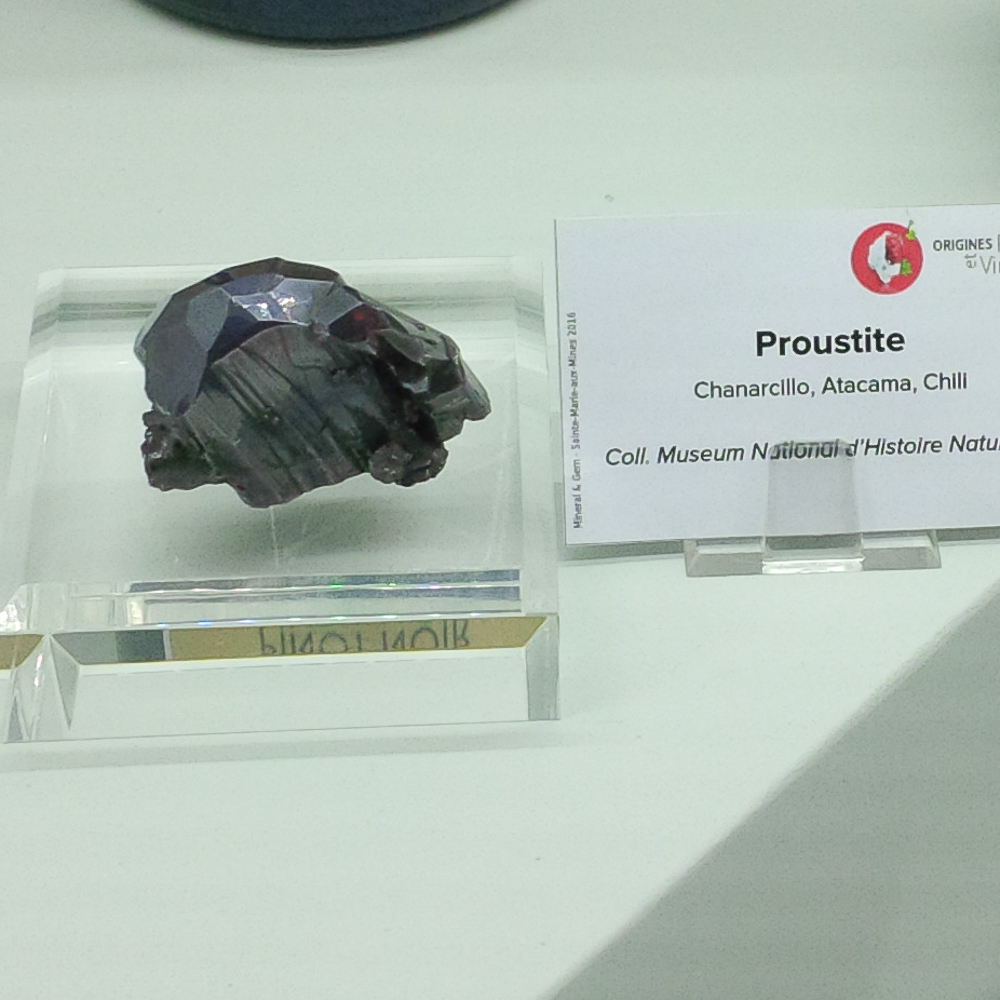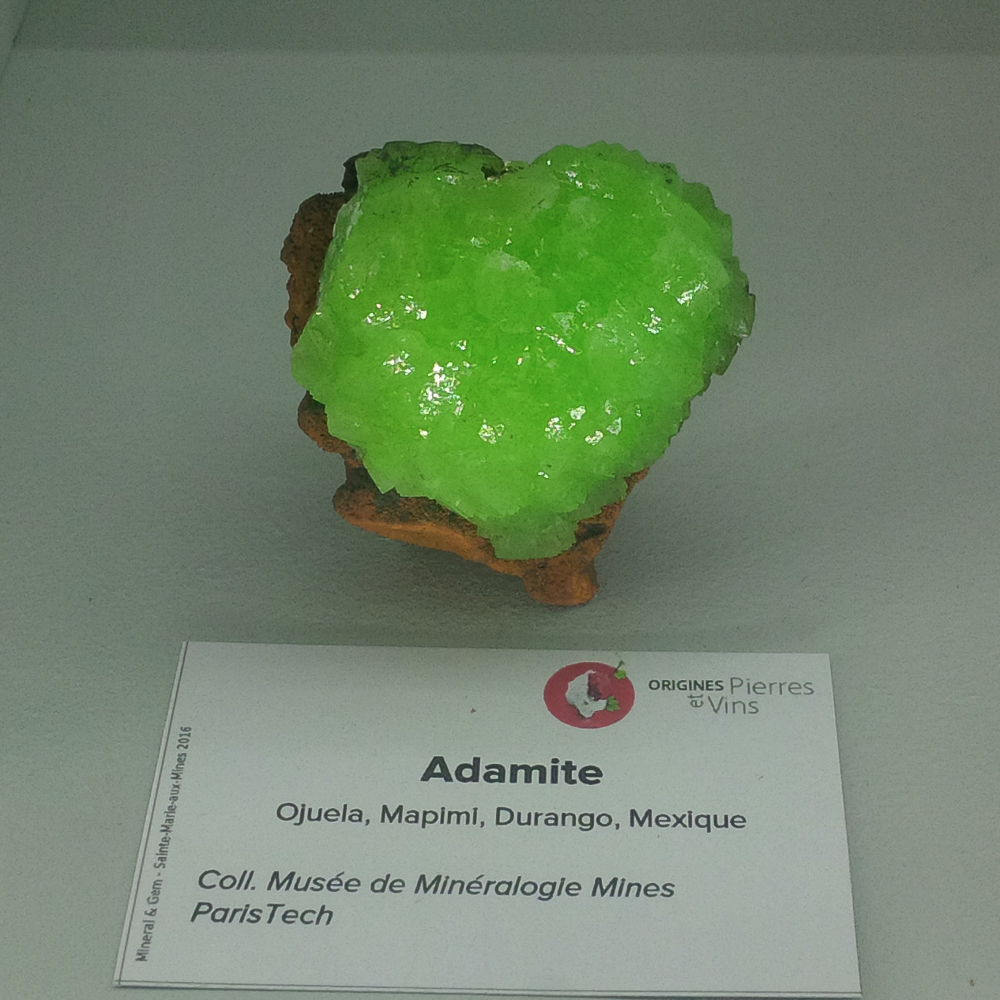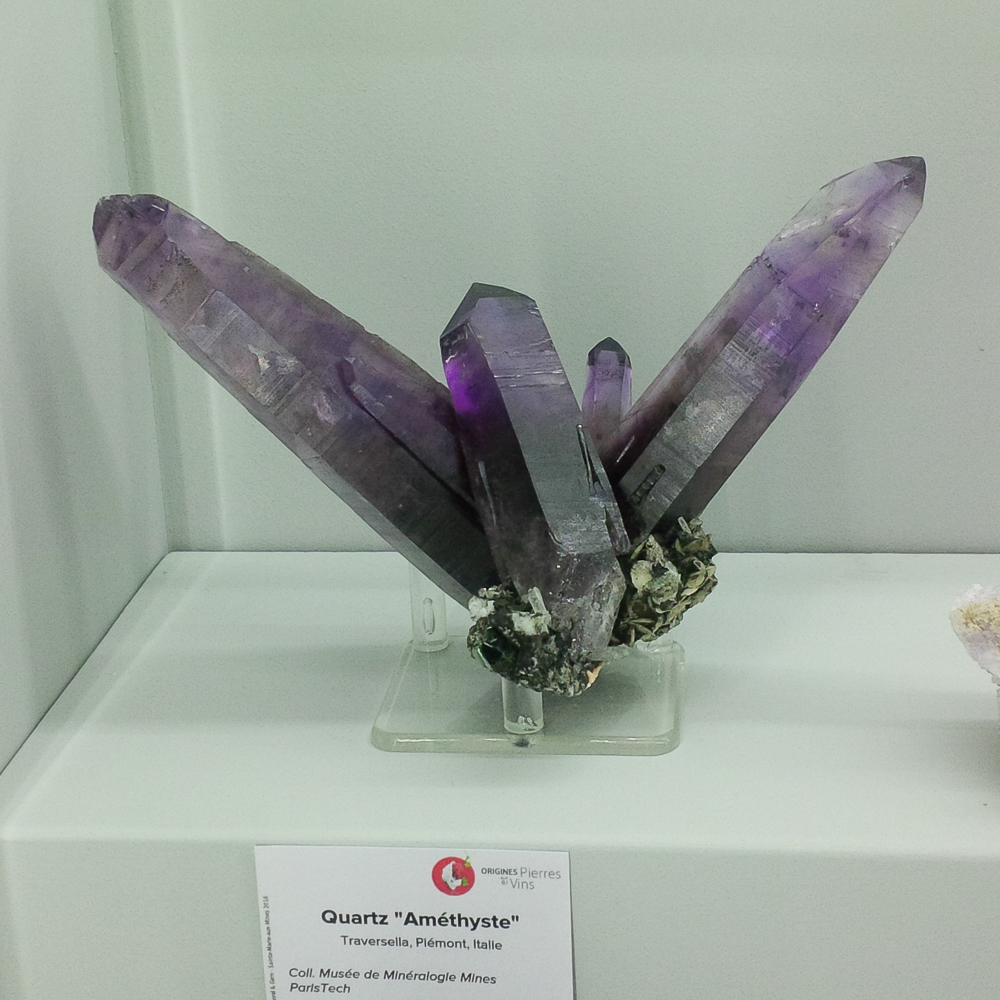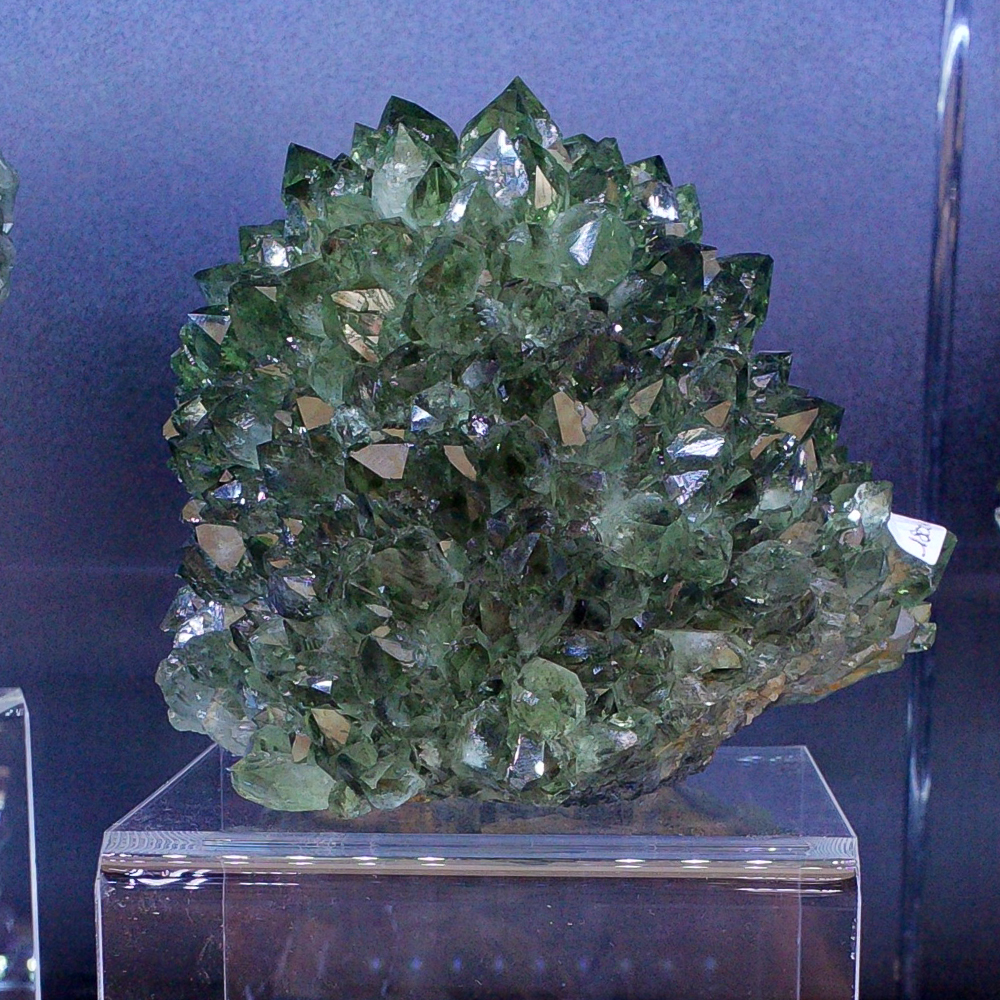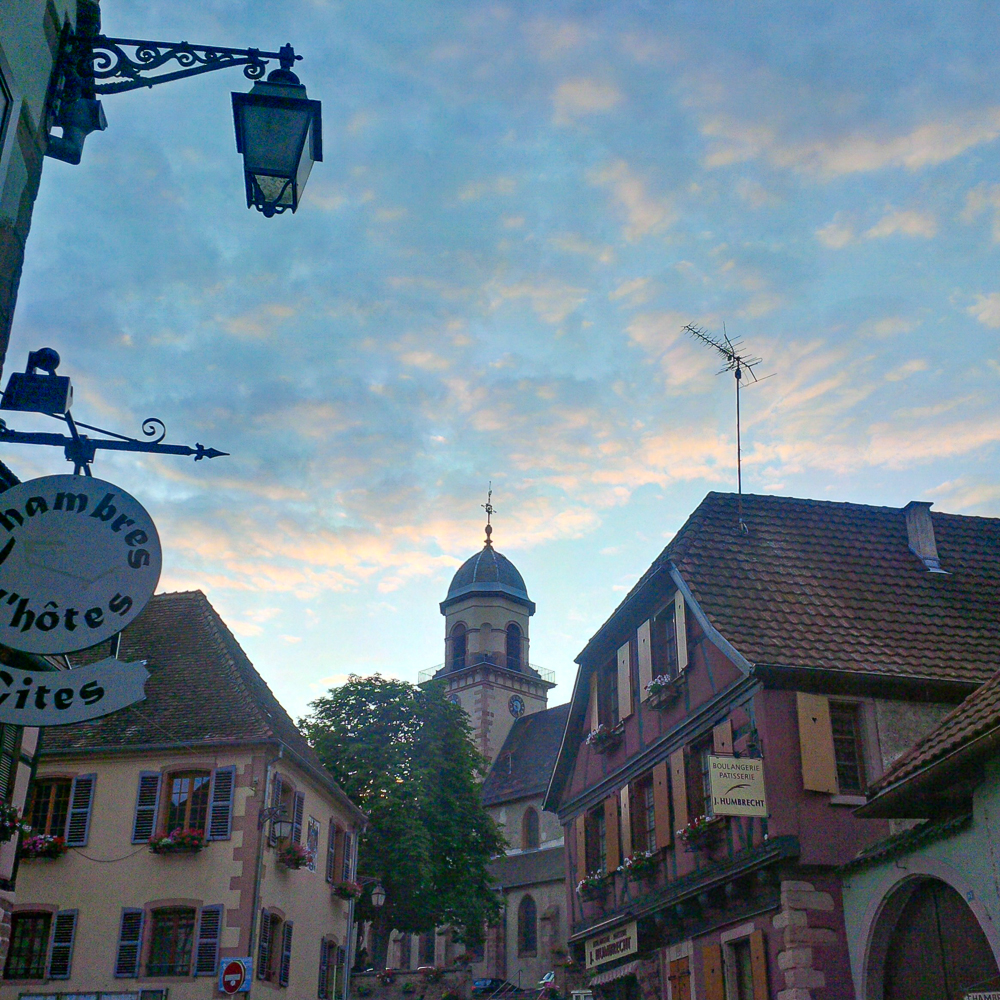Categories
Archives
In a valley in the Vosges region of France, the quiet town of Sainte-Marie-aux-Mines transforms into a bustling mineral and gem extravaganza every June. This is the most beautiful setting for any of the world’s major annual mineral shows, and attending is a great experience.
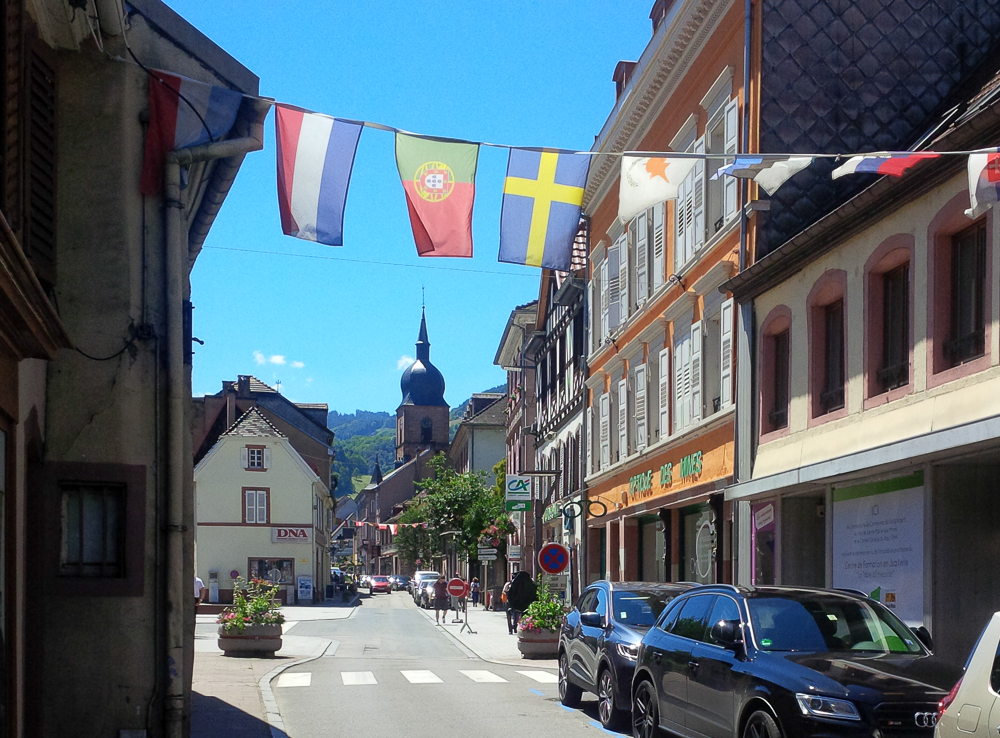
Sainte-Marie-aux-Mines, 2016
Although there was much stormy and unsettled weather across France and Germany this year, the towns of this area escaped the more significant flooding damage that affected so many communities elsewhere. The Rhine was certainly swollen with much more water than usual – and thunderstorms left debris on the roads – but for the most part, the rains just meant lots of green across the countryside.
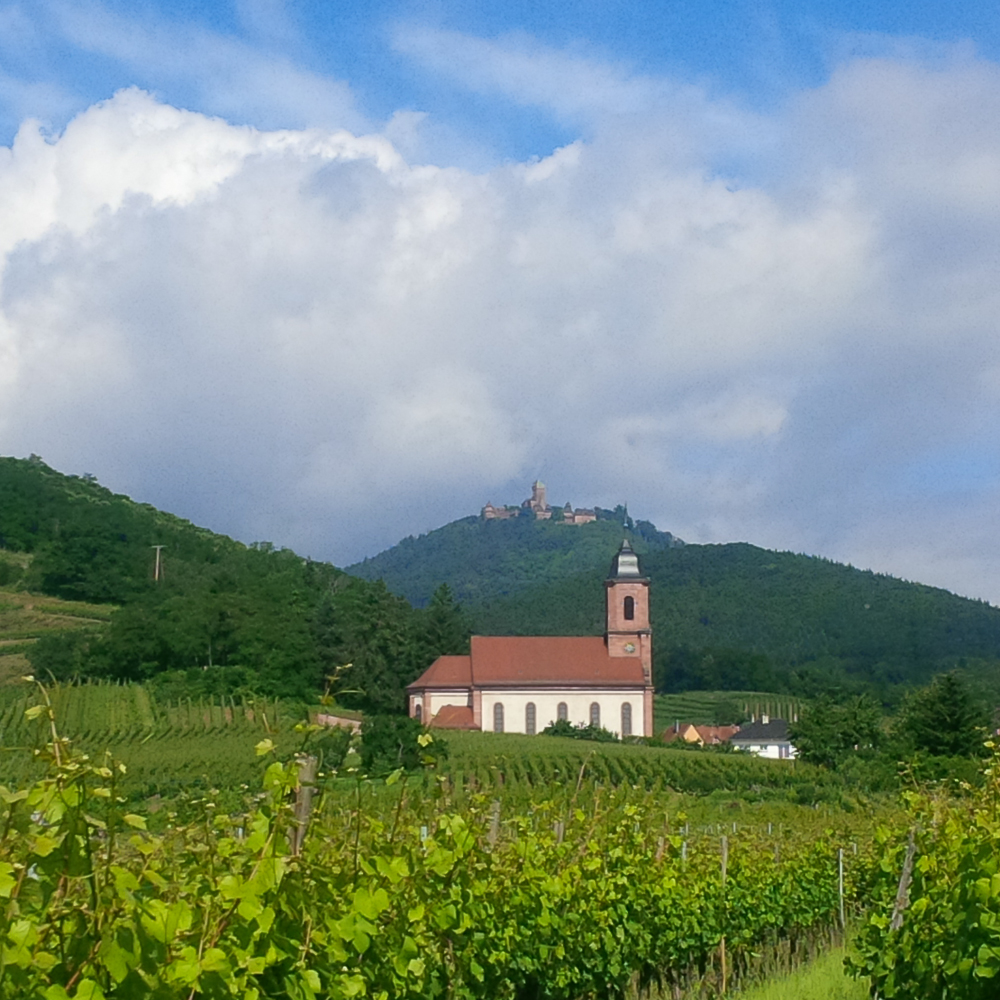
Vineyards, near Orschwiller. Chateau Haut Koenigsbourg is perched above, in the Vosges mountains.
I love the region’s idyllic small towns – quiet, with the calls of blackbirds overhead.
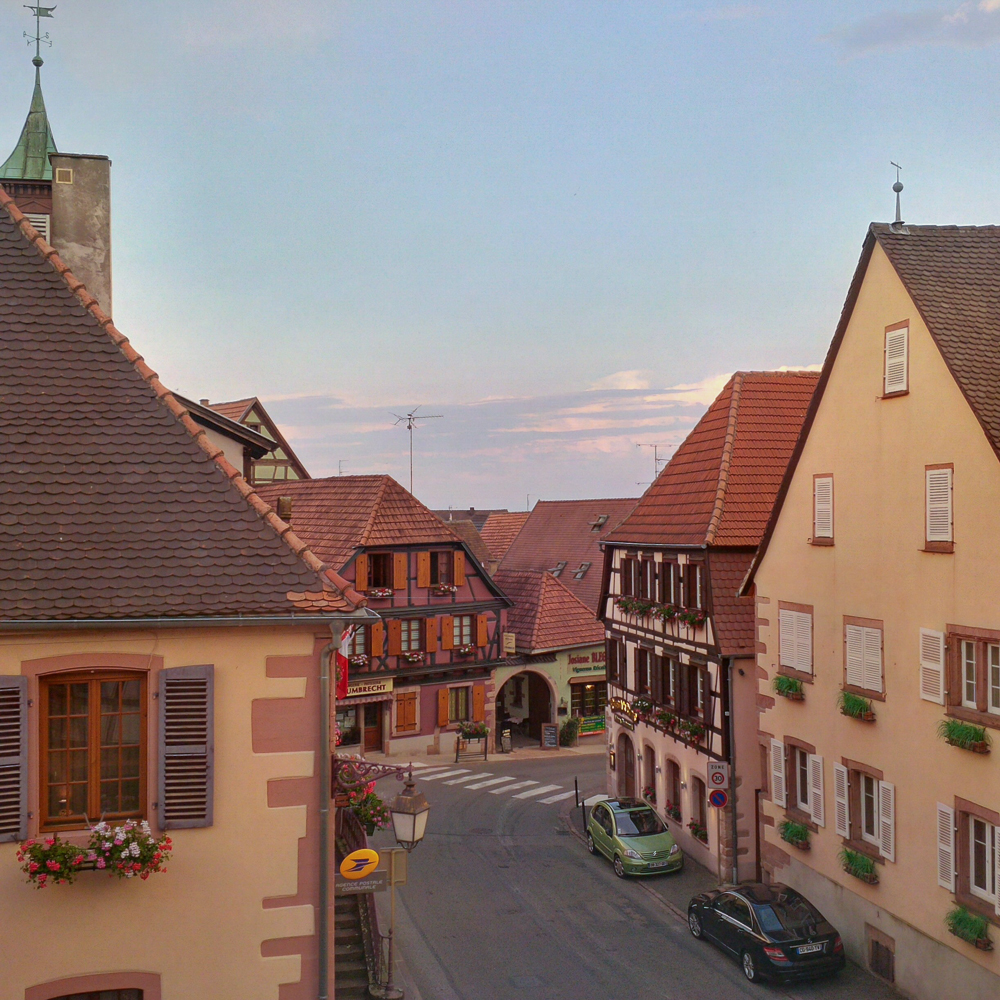
Saint Hippolyte, Haut-Rhin, France
Beautiful Alsace architecture bathed in a warm evening light
In the town of Ste. Marie itself, one of my favourite things about its setting is that the valley is quite steep, and so the forests and pastures form a backdrop for many of the views from down in the middle of the town.
Saint-Marie-aux-Mines, Val D’Argent, France
The river and waterways of the town are channeled behind the houses and other buildings – and normally at this time of year there isn’t much water. This year, there was lots!
Bubbling water channel running through Sainte-Marie-aux-Mines
One thing that really stood out this year was the temperature – it was HOT! Humid too. Lots of sun and haze… and you also had to watch for the late-afternoon thunderstorms.
Signs of impending rain at Sainte-Marie-aux-Mines 2016
So I did see this one coming…
Thunderstorm coming from up the Val D’Argent
…and I thought I had time to make it back to the car, but… ended up sheltering part way there, when the skies opened up!
Rainwater streaming from waterspouts directly into the water channel that runs behind the houses – efficient!
The storms were short and did not make life uncomfortable for long – they were actually refreshing. In fact, there was something that made things far more uncomfortable at the show…
300W halogen lights on stands. It is hard to find a hotter mainstream light source (!) – these were all over the indoor dealer displays.
I love the colour quality of halogen lights, but these things are stoves on sticks.
One of the tent-lined streets at Sainte-Marie-aux-Mines
For me the most exciting new find at Ste. Marie was actually not on public display. Tomasz Praszkier brought out the top new Moroccan aragonite specimens and they are truly superb! Aragonite is not a rare mineral, of course, and some aragonite localities are rather abundant producers, so, for example, we typically see lots of aragonite available from Tazouta, Morocco, and also from Minglanilla, Spain. (Even in those instances, truly fine specimens are not the rule, as the vast majority are damaged). These specimens exhibit twinning, with pseudo-hexagonal cyclic twins of aragonite. However, these new specimens from Mamsa are classic, elongated, tapered orthorhombic crystals in groups of radiating spikes and make for dramatic specimens. Even though aragonite itself is uncommon, it is very hard to acquire high-quality specimens of this most classic habit.
In this case, Tomasz went through hundreds of flats (yes flats (!)) of material in Morocco, and the specimens I acquired from him are all in the top 20 to date (top 20 pieces, not flats!). Almost everything he saw was badly damaged. This bulk of lower quality material will undoubtedly begin to show up at future mineral shows, but – interesting – it was almost entirely absent among the Moroccan dealers in Ste. Marie.
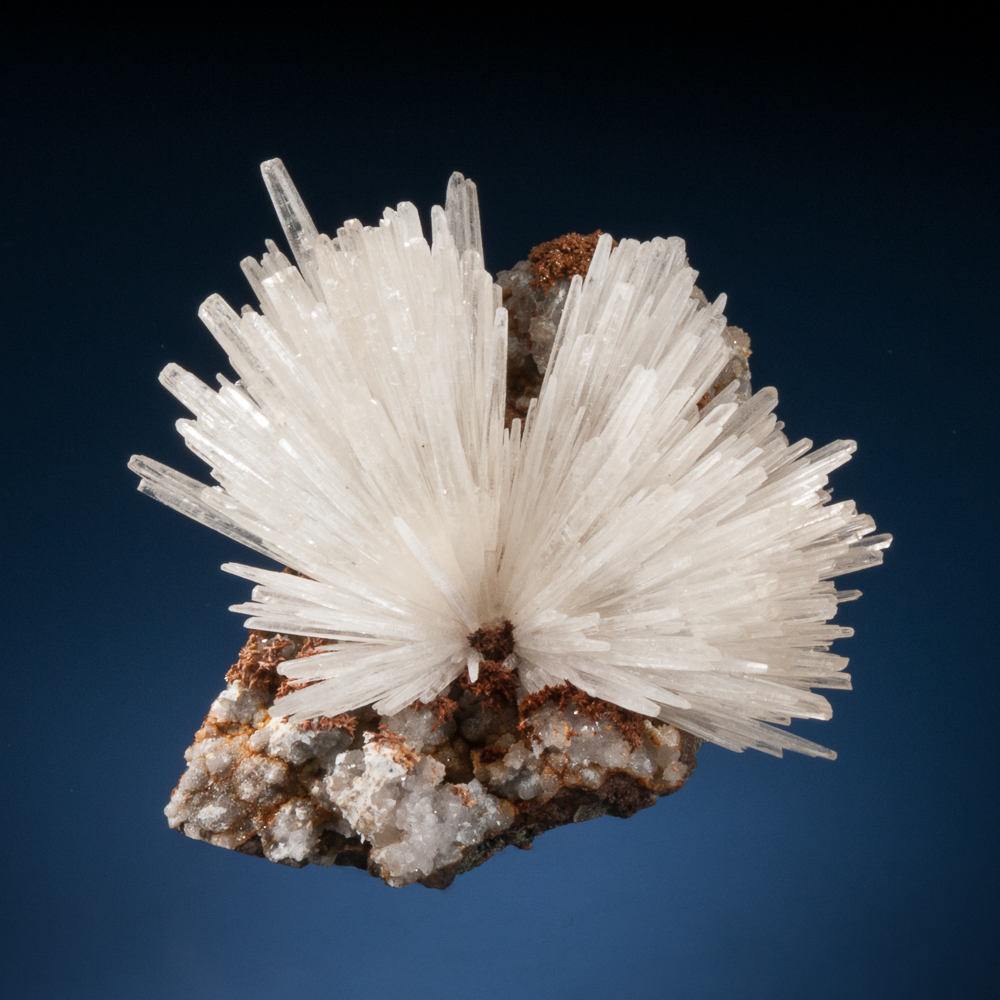
Aragonite, Mamsa, nr. Sidi Ayed, Boulemane Province, Fes-Meknes Region, Morocco – 7.5 cm
Aragonite, Mamsa, nr. Sidi Ayed, Boulemane Province, Fes-Meknes Region, Morocco
Field of view 6 cm
It is notable that the aragonite at this locality does also occur in other habits, including as elongated pseudo-hexagonal twins, so we may see those in future. The locality itself is well-exposed in a barren area north of Sidi Ayed. The difficulty is that the material closer to the surface has been extracted, and this was the matrix that was easier to collect – as they’ve gone deeper, the matrix has been tougher, and the material from these deeper excavations has been damaged. Most collecting there has been by local collectors who are more often digging agates, and of course collecting these delicate aragonite sprays required different techniques and care – hence the high level of damage with most of this material.
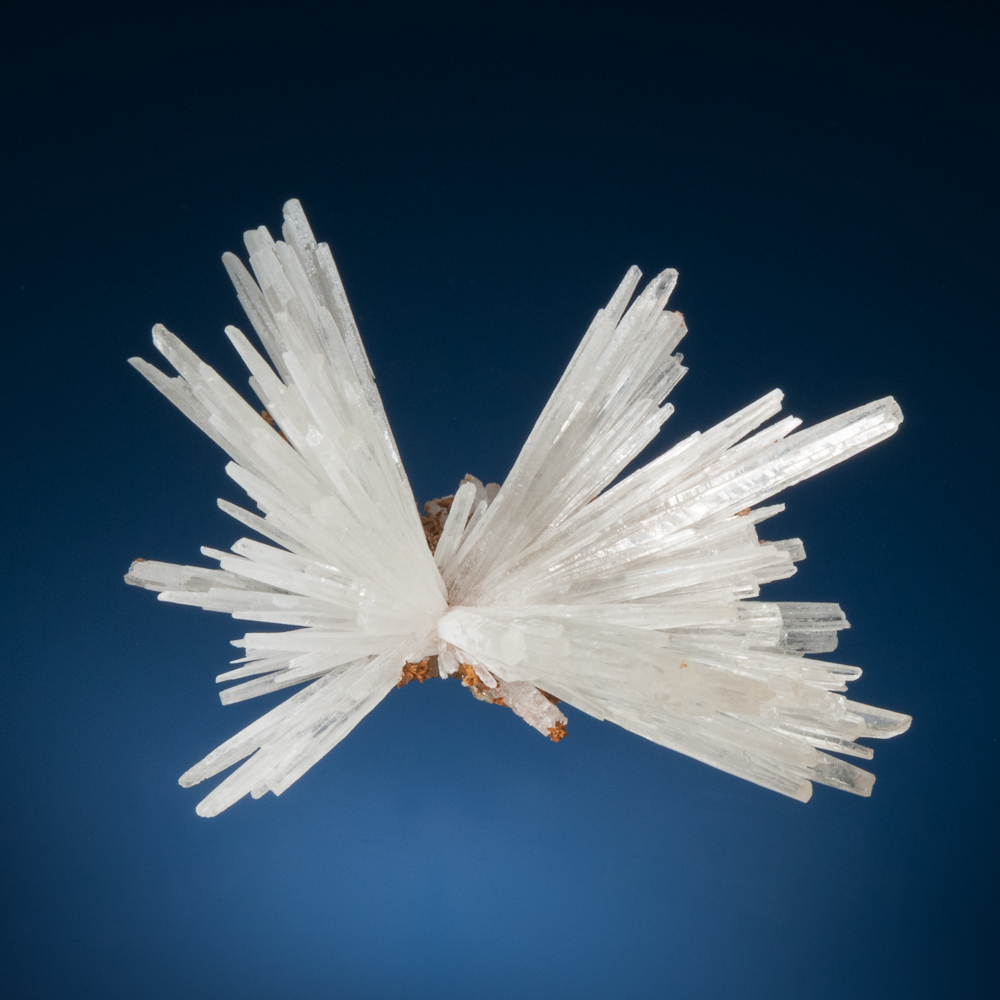
Aragonite, Mamsa, nr. Sidi Ayed, Boulemane Province, Fes-Meknes Region, Morocco – 6.9 cm
As usual, there were many Moroccan dealers with the usual – most had very typical material, in moderate condition. One interesting new find was some purple fluorite, from very narrow seams at a locality Elyachi, near Tatouine.
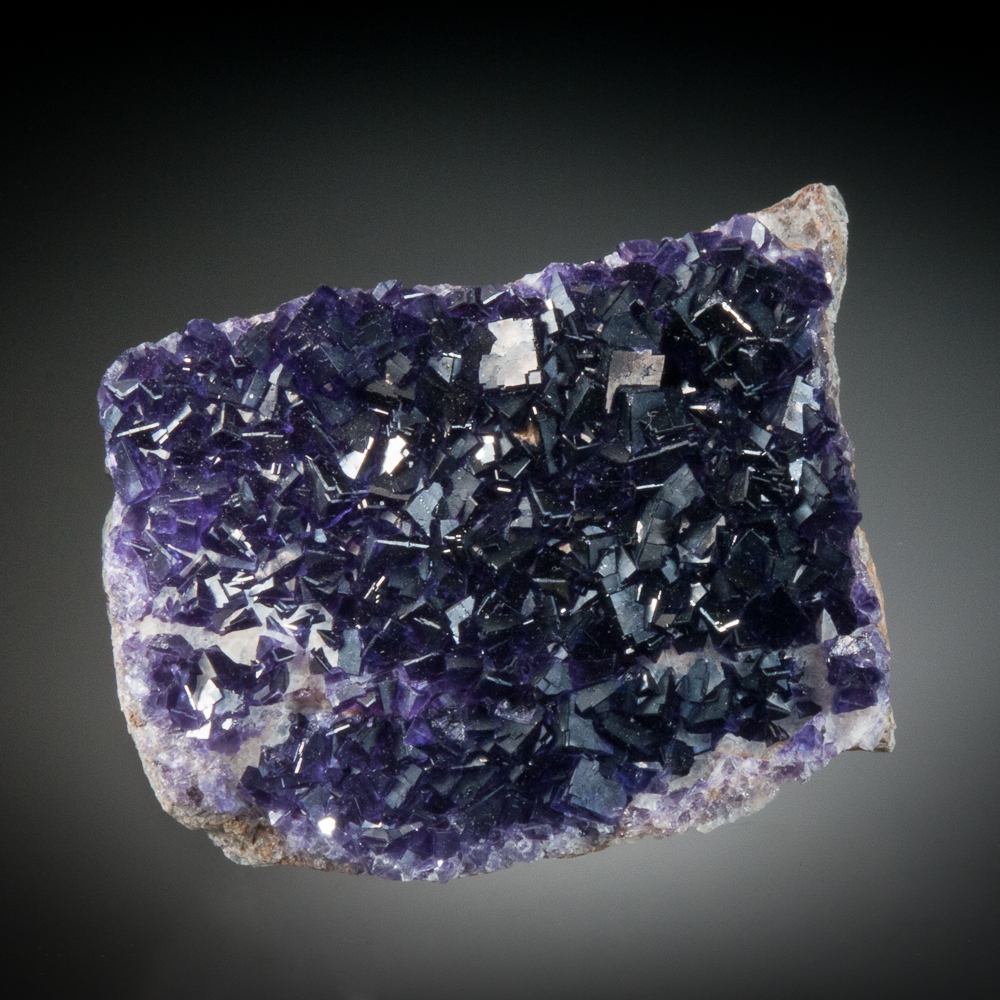
Fluorite, Elyachi, nr. Tatouine, Meknes-Tafilalet, Morocco – 8.2 cm
One last note from Morocco is that the production of the beautiful blue barites from Sidi Lahcen (these ones) is reportedly finished. Although we always have to be skeptical when we are told that a locality is exhausted, the marketplace confirmed it in Ste. Marie this year, with almost no truly high-quality specimens available.
Speaking of high-quality specimens one cannot track down… I had hoped to bring back a few more of the bright yellow stilbite ball specimens from Mali (if you aren’t familiar with them, some are here). Although there were some at the show, they were all too damaged for our collections – I’m not sure that any were new. I suspect that most were the low-quality pieces from the original collecting of this material. I continue to keep an eye out for them, as they are some of the nicest yellow stilbite specimens I’ve ever seen, and they look so great in the cabinet. We’ll see what the future brings. In the meantime, I was able to pick up some excellent prehnite/epidote specimens from Mali, along with a sharp, lustrous vesuvianite.
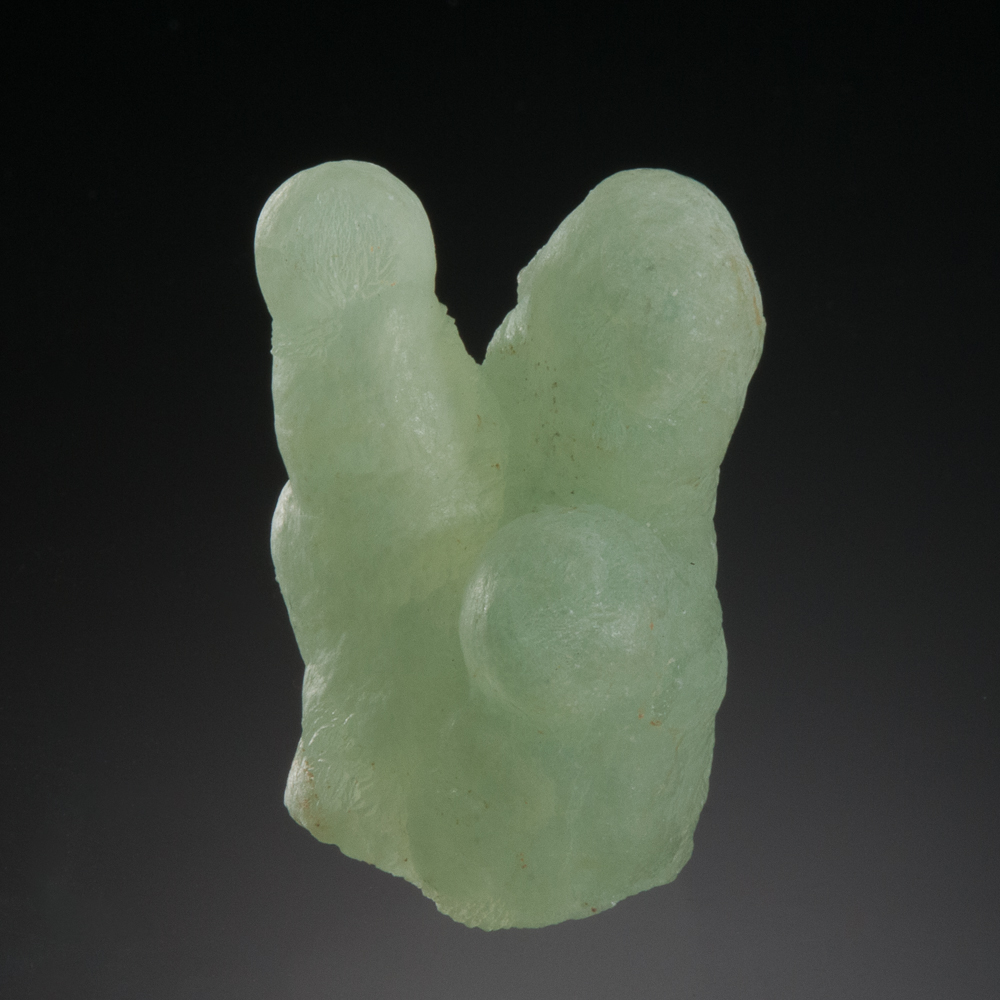
Prehnite, Arrondissement Diako, Cercle de Bafoulabé, Kayes Region, Mali – 4.3 cm
New from France, French collector Grégoire de Bodinat recently collected some beautiful specimens at the Mésage Mine, Saint-Pierre-de-Mésage, Isère, France. The Mésage Mine was originally explored in the early-nineteenth century for iron, and the underground workings have been abandoned since the late-nineteenth century. Grégoire had a nice selection of high quality specimens from this classic region – siderite with quartz, ankerite crystals, and sharp bournonite crystals with white barite.
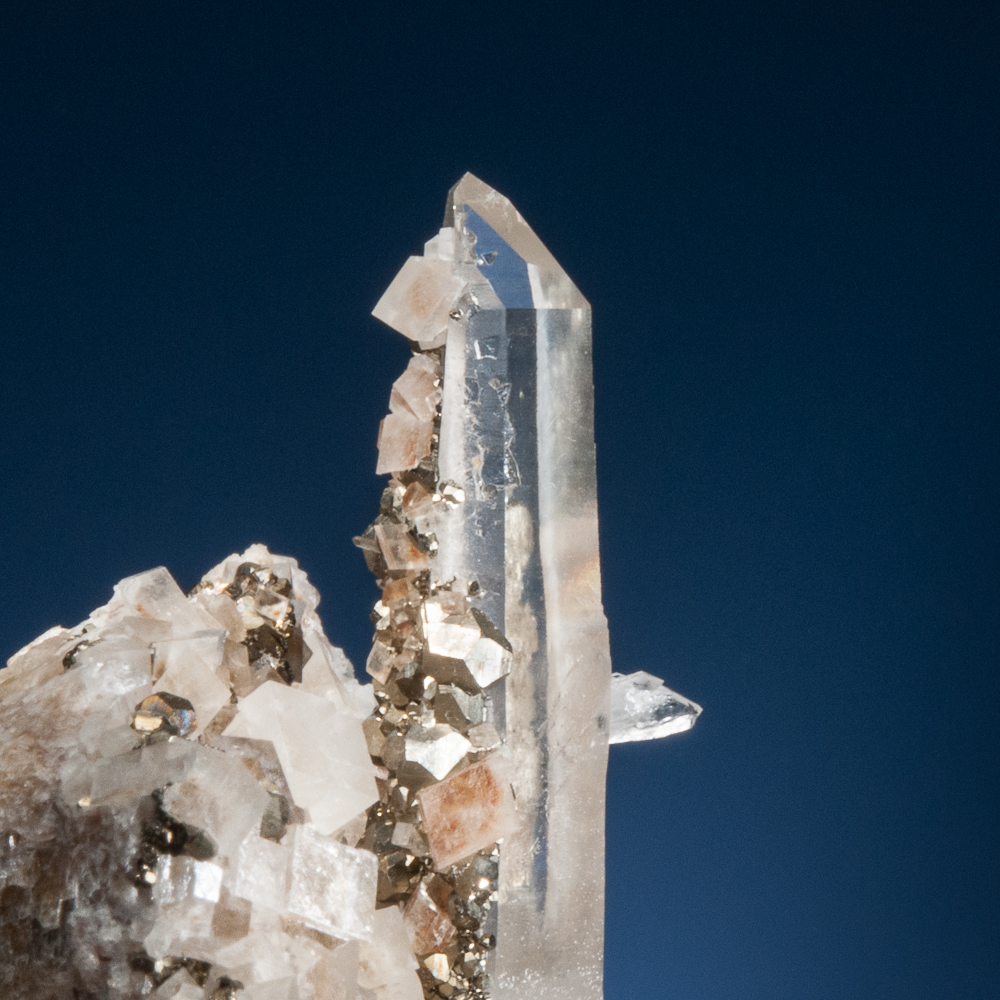
Ankerite and Pyrite on Quartz, Mésage Mine, Saint-Pierre-de-Mésage, Isère, France
Ankerite and Pyrite on Quartz, Mésage Mine, Saint-Pierre-de-Mésage, Isère, France – 6.6 cm
Pyrite and Quartz on Siderite, Mésage Mine, Saint-Pierre-de-Mésage, Isère, France
Siderite with Quartz, Mésage Mine, Saint-Pierre-de-Mésage, Isère, France – 4.9 cm
Bournonite, Barite, Mésage Mine, Saint-Pierre-de-Mésage, Isère, France
The Mésage Mine specimens are on the website here.
Finally, another great new find is from the Rudna Mine, Lubin District, Lower Silesia, Poland. This is of gypsum, var. selenite, with inclusions of herbertsmithite (a rare copper chloride mineral), making the specimens a vibrant green colour. These are gorgeous cabinet specimens! There were not many of these, and only a handful were top quality – I acquired all of the top quality ones.
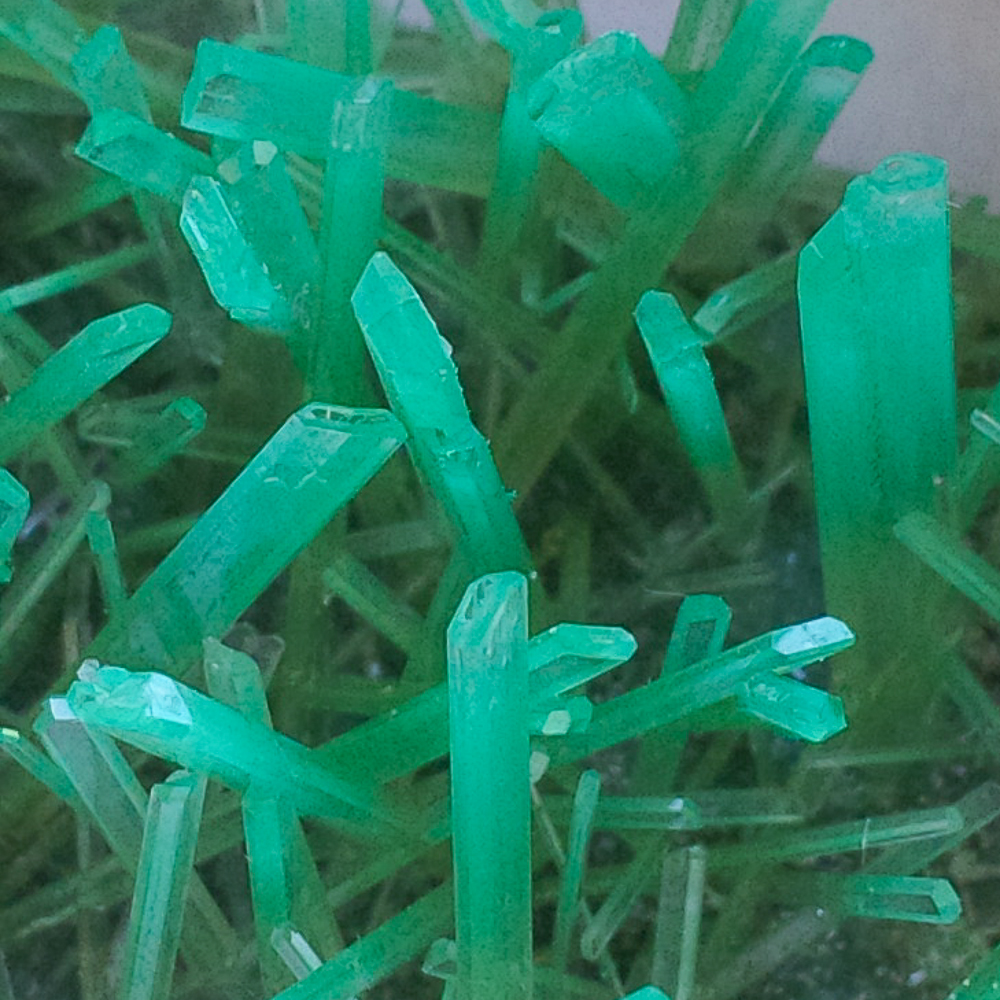
Gypsum, var. Selenite, with inclusions of Herbertsmithite, Rudna Mine, Lubin District, Lower Silesia, Poland
Crystals up to approximately 3 cm
Displays
The Saint-Marie-aux-Mines show has hosted super displays in recent years.
This year, the main theme was Minerals and Wines (“Origines Pierres et Vins”), with some cases dedicated to matching mineral colours and wine colours, and others featuring the wines and minerals of a particular region.
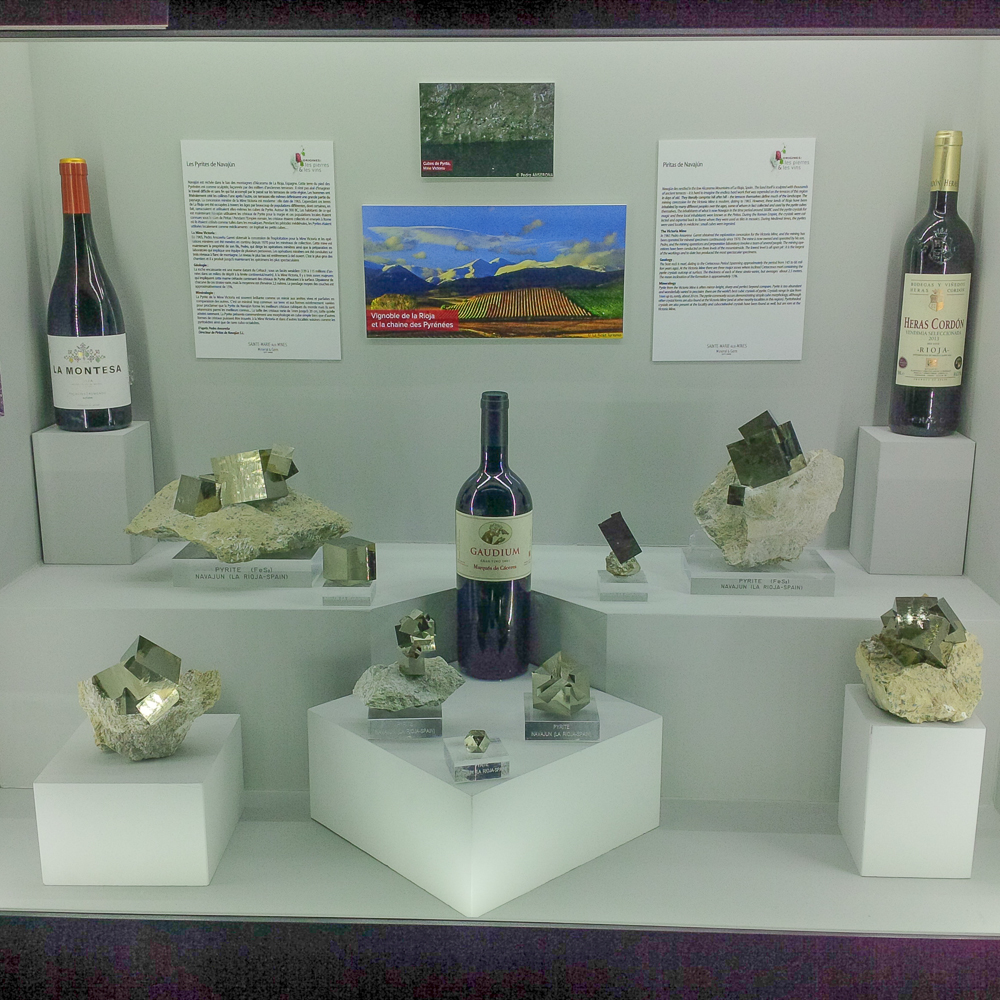
Rioja, Spain – home of great wines and the incomparable pyrites of Navajun
Display by Pedro Conde
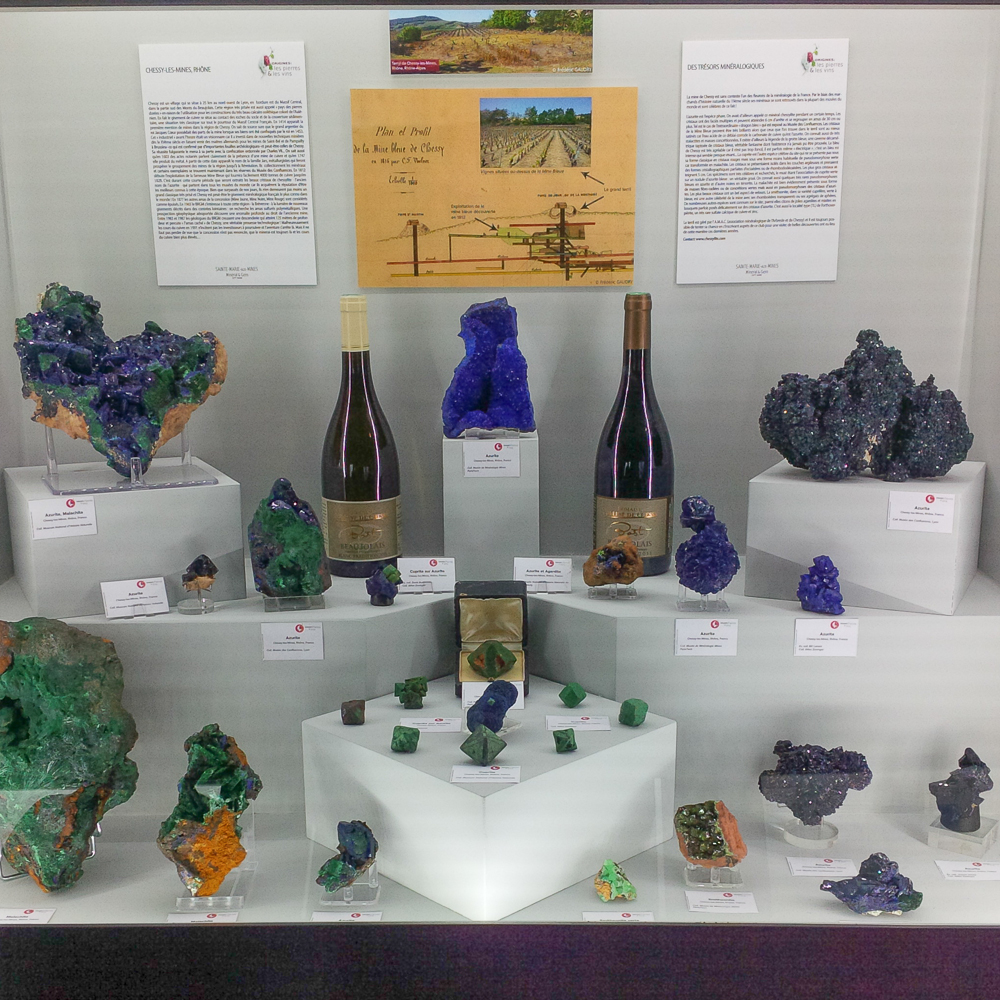
The minerals and wines of the Chessy-les-Mines, Rhône
The Chessy case had some amazing specimens – here is a closer look at a few:
Cuprite crystals, Chessy-les-Mines
Azurite, Chessy-les-Mines – a gorgeous specimen,approximately 9 cm
From the Origines Pierres et Vins cases, I loved this Chanarcillo Prousite from the Collection of the Museum National d’Histoire Natural in Paris.
Proustite, Chanarcillo, Atacama, Chile – approximately 4 cm
The exposition also included a few cases dedicated to colours in minerals, explaining what causes the colours in certain minerals. These cases included many stunning specimens and here are a few.
This adamite was an amazing hue – approximately 5 cm
This next one looks at a glance like it’s a classic from Amatitlan, Guererro, Mexico, but look at the label… (!)
Amethyst, Traversella, Piedmont, Italy, approximately 20 cm
This photo doesn’t do this crystal justice – an astounding, lustrous, old-time Red Cloud wulfenite, pristine…
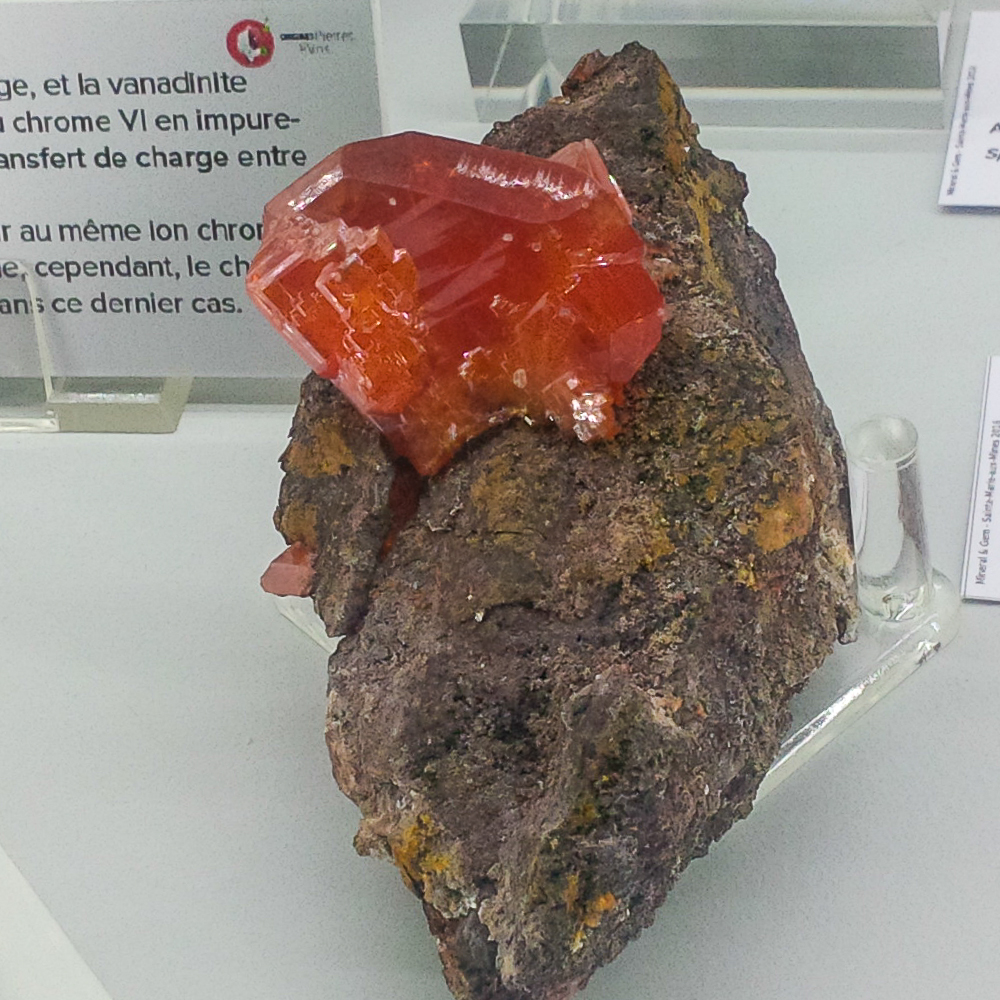
Wulfenite, Red Cloud Mine, La Paz Co., Arizona – crystal approximatey 4 cm
Collection of the Musée Mineralogie de Mines, Paris Tech
And finally, while we’re on the subject of the causes of colour in minerals, and leaving the displays… I wandered into one dealer with new crystals of “Amegreen” (!). These are Uruguayan amethysts that have been subjected to radiation in a lab, to turn them green. Blech!! (At least the dealer was openly disclosing the origins of the colour.)
Quartz, originally var. amethyst, tortured and turned green in a lab using radiation – marketed as “Amegreen”
Artigas, Uruguay
Sainte-Marie-aux-Mines is such a great show. I already can’t wait for next year, and hope to see you there!
Beautiful summer evening in Alsace


